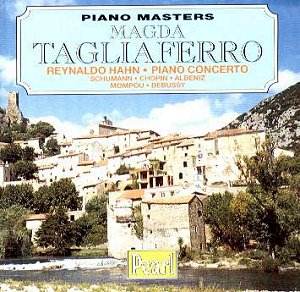Brazilian born but French trained, Magda Tagliaferro
was the embodiment of Gallic vivacity and élan. One of
her teachers happened to have been Cortot and she soon fell into
the most rarefied company, being selected by Fauré to tour
with him in 1910. A battalion of fiddlers queued up to engage
her – Enescu, Thibaud and the venerable scion of the French school,
Jules Boucherit. She knew them all – d’Indy, Falla, Villa-Lobos,
Poulenc, Pierné and many, many others. She taught in Paris
and in Brazil and made her début at Carnegie Hall at the
incredible age of eighty-six (when she made her Wigmore Hall debut
she was, I believe, even older). She gave her last recitals, aged
ninety-two and blind in the year of her death, 1985.
Her records are relatively scarce and this is
a delicious selection of them, recorded between 1930 and 1934.
The Hahn Concerto, conducted by the composer, I once saw written
up (it was a compliment) as ‘chic’. There’s no doubt about it;
the liquid and romanticised tracery of the opening Improvisation
finds its most adroit and perfect foil in the ardent filigree
of Tagliaferro. The movement is a delicious example of gorgeous
frippery perhaps but how fabulously she parades it. And how witty
she is in the Danse second movement and how well she gently underlines
the Rachmaninovian inheritance to which Hahn was subtly heir.
In the capricious toccata and finale she is full of lyricism,
riding those mock suspensions like a surfer cresting the wave.
The unnamed orchestra is splendid and the recording, good for
its time, sounds even more splendid here.
His little Sonatine follows, a recording made
slightly earlier than the Concerto. Hahn shows his obeisance to
the native clavichord tradition in the opening Allegro non troppo
before etching the slow central movement with beautiful simplicity
and his tambourin finale with brisk effusion. A jeu d’esprit –
but at nine minutes never one to outstay its elegant, knowing
welcome. We are on to more central repertoire with Faschingsschwank
aus Wien; the opening is marvellously animated, the Romanza
sustained with the greatest of intensities (she was no superficial
treble teaser), her rhythm in the Scherzino is triumphant and
her tonal beauty best exemplified in the Intermezzo – which happens
to contain some of her most eloquent romanticism. That she had
a wide tonal palette can be heard in Chopin’s Impromptu which
is full of telling detail – rubato and splendid voicings as well.
The Albéniz courses with pearl toned treble, marvellously
rounded bass and rhythmic bravura. As for the Mompou she was a
discographic pioneer being the first ever to record a piece of
his. She explores the evocative romanticism of his La Rue,
le Guitariste et le Vieux Cheval with total sympathy. The
final items, by Debussy, come from slightly noisier Ultraphones
of 1932 but we can still admire her idiomatic control over Jardin
sous la pluie and Toccata.
The transfers are excellent; good copies have
been used and this release in Pearl’s Piano Masters series fully
lives up to its billing – indeed surpasses it in sheer vivacity.
Jonathan Woolf
